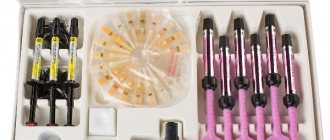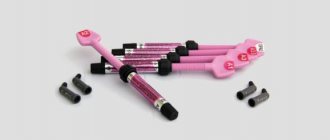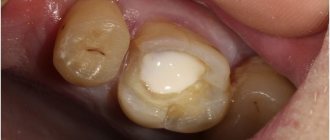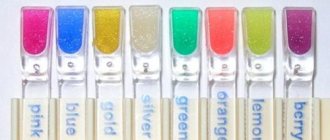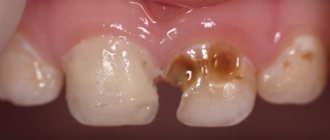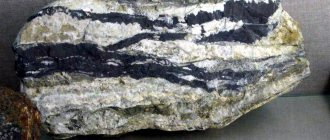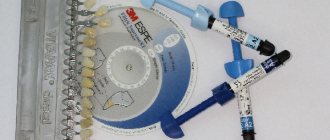The most common problem in the oral cavity, which 90% of people face, is caries. It is treated with a filling. There are now quite a lot of varieties of filling composites. Let's consider modern high-quality material made in Japan "Estelight". These are light-curing filling materials that are used by dentists for filling and restoration of teeth. Due to the presence of a large number of shades, it is possible to fill both the chewing teeth and the front teeth.
What is a light seal and how is it different from a regular one?
Light filling refers to modern composites that are manufactured under the influence of a strong light source. This material contains a substance that is sensitive to light. Under the influence of ultraviolet radiation, it breaks down into radicals and thus a polymerization process occurs in the filling itself. Thanks to this, the shade that the dental filling material acquires is quite similar to the color of the nearby dentition.
Unlike a conventional filling, the luminous material hardens under the influence of a polymerization lamp, and the dentist can more accurately adjust it to its shape. In addition, such a filling is more durable than a regular one, and it is also easier to match the color to the dentition. To a prying eye, the light composite or reflector is invisible.
Let's make your smile perfect!
If you want to have your teeth restored with light-cured filling material “Charisma”, “Gradia” or another brand, please inform your dentist. Can't make a choice? Just rely on the specialists of our clinic, they will select the ideal option for you. All composites used in our clinic are of high quality and reliability. Therefore, you will definitely be pleased with the result!
To make an appointment at the DENTISTRY clinic, call +7 (8342) 308–088 or fill out the form below.
Estelite filling material: features and release form
Recently, dentists have been using Japanese materials to restore or restore tooth enamel. Their polymerization occurs in just 10 seconds (one layer), while the composite retains its softness and plasticity.
Using the material, you can mask through and volumetric defects, select the appropriate shade, which over time will acquire the color of the dentition. Dentists note that using the composite is very convenient, since it does not stick to the instrument and holds its shape well.
Estelite filling material is produced in special syringes with a volume of 3.8 grams and unit doses of 0.2 g, depending on the shades.
Common shades:
- BW – for pre-whitened teeth;
- WE – light-colored enamel;
- CE – transparent enamel;
- OA1-OA3 - opalescent shades that are used to restore the oral cavity of the 3rd and 4th classes.
You can also use shades as dentin shades if you restore tooth enamel in several layers at once. The material is suitable for baby teeth, but is not used on metal dentures.
The composite contains 82% silicon and zirconium, due to which shrinkage is minimal, and strength and wear resistance are high. It is a universal and easy-to-use material.
Composition and properties
The constituent elements of the material provide excellent mechanical and physical characteristics, and also guarantee high strength and high-quality aesthetic results.
Maximum shrinkage of the material after restoration is ensured by 82% of the silicon-zirconium mass in the composition.
Thanks to the assortment line of color solutions (more than 20), a specialist can easily select the optimal shade at the stages of restoration.
The paste lends itself well to polishing , and the resulting result does not change the original characteristics in appearance over a long period of time.
Estelite is a product distinguished by its abrasion resistance and high wear resistance.
Methods of obturation of root canals and stages of the procedure.
Visit here to learn more about the purpose of Twinky Star colored fillings.
At this address https://zubovv.ru/lechenie/zubyi/plombyi/retrogradnoe-kornevyih-kanalov.html you will find all the most important things about the retrograde filling method.
Areas of application
Dentists actively use Estelite fillings to treat dental caries. The material is used both for lateral (chewing) teeth and for restoring the aesthetics of enamel on the front teeth. Thanks to a special composition developed by Japanese scientists, the composite is resistant to mechanical abrasion and the surface shines.
Since this filling material is universal, it is used for both adults and children to treat baby teeth. The composite has also proven itself well on the dentition with veneers, in eliminating diastema, restoring the occlusal surface and opacity of the tooth. There are more than two dozen shades of fillings. But they are not used on teeth that have lost their color under the influence of tetracycline.
Universalism and aestheticism
The use of nanocomposites is universal. It is suitable for working with both front and lateral teeth. Is used for:
- restoration of artificial teeth;
- elimination of interdental spaces and gaps (diastema);
- layer-by-layer application of thin overlays on teeth (composite veneers);
- restoration of all types of carious cavities;
- direct manipulation of the front and side teeth, including their cutting and chewing surfaces.
The material contains methacrylic monomers designed to modify the properties of polymer materials, improving them. A contraindication to the use of the composition is an allergic reaction to any monomers similar to methacrylic ones.
Principle of operation
Working with Estelite filling material is easy and simple, and filling occurs quickly, dentists note. Due to the same depth of demineralization and penetration of adhesive substances, the dentinal structures are filled simultaneously. The design as a whole is monolithic, without cracks, regardless of the structure of the surface of the tooth enamel.
An aesthetically attractive, high-quality and durable filling is placed in a minimum amount of time. In this case, caries no longer occurs in this place, since the material releases fluoride ions.
Mode of application:
- The surface of the dentition is treated with paste (without fluoride).
- The appropriate shade is selected (filling of whitened teeth can be done no earlier than two weeks after the procedure).
- The tooth is isolated using a rubber dam and the cavity is sanitized.
- In order to avoid sharp changes from the restored area to the edge, the enamel of the lateral tooth is smoothed, and a bevel is made along the edge on the front dentition.
- To restore an artificial tooth (ceramic or composite), a diamond bur is used to increase adhesion and roughen the surface.
- Etching occurs using phosphoric acid.
- A glass ionomer material or calcium hydroxide liner is used to protect the pulp.
Estelite instructions
1. Cleaning Thoroughly clean the tooth surface with a rubber cup containing fluoride-free paste, and then rinse with water.
2. Shade selection Before installing the rubber dam, select the appropriate shade using the Estelite Sigma Quick shade guide.
- The shade must be selected within 5 minutes; Dry teeth are lighter than moistened teeth.
- White saturation (color intensity) is the most important factor in choosing a shade.
- If you're debating between two shades, choose the lighter shade (the shade that has the most color intensity).
- When working with whitened teeth, shade selection should be done a few weeks after the whitening procedure. Whitened teeth may darken slightly.
3. Isolation Rubber dam is the best method for isolating a tooth.
4. Preparing the cavity Prepare the cavity and rinse thoroughly with water. Bevel the edges of the enamel when preparing anterior teeth (Class III, IV, V) and smooth the edges of the enamel when preparing posterior teeth (Class I, II). Bevels and smoothing of the enamel edges ensure that the boundary between the cavity edge and the restoration disappears, improving aesthetics and retention. — From the point of view of aesthetics and strength, scalloped bevels (undulant, scalloped bevel) are preferable. — When restoring ceramic or composite restorations, roughen the surface with a diamond bur to improve adhesion; for cleaning purposes, etch the tooth surface with phosphoric acid; rinse thoroughly with water; dry the tooth surface and apply silane according to the manufacturer's instructions.
5. Protection of the pulp If the cavity is located in close proximity to the pulp, a gasket made of glass ionomer material or calcium hydroxide should be applied. EUGENOL BASED MATERIALS SHOULD NOT BE USED for pulp protection as they will inhibit the polymerization of the bond and/or ESTELITE Σ QUICK.
6. Adhesive System Apply light-curing adhesive system according to the manufacturer's instructions. We recommend using TOKUYAMA BOND FORCE, which is a one-part, self-etching, light-curing dental adhesive. — Self-curing adhesive systems should not be used. With Estelite we recommend the use of light-curing adhesive systems, since other types of adhesive systems, such as, for example, self-curing adhesive systems or dual-curing systems, will not provide effective adhesion when using light-curing composite materials. If you do use self-curing or dual-cure adhesive systems, make sure they can be used with light-curing composite materials.
7. Dosing 7-1. Unidose (PLT) Before use, carefully read the Special Instructions for Use of Unidose. — Place the PLT in a suitable dispenser. — Remove the PLT cap. — Apply the paste directly into the cavity or pre-squeeze it onto the mixing plate.
7-2. Syringe Remove the cap of the syringe. Turn the handle clockwise to squeeze out the paste onto the mixing plate. Immediately after this, put the cap on the syringe. - DO NOT apply excessive force to the syringe if it has just been removed from the refrigerator.
8. Filling and contouring of the restoration Bring the material into the cavity layer by layer. The layer of material should not exceed the specified depth (check the table above). - DO NOT mix Estelite Sigma Quick with other types of composite materials or other shades of Estelite Sigma Quick to avoid incomplete polymerization or voids.
9. Curing Cure each layer for at least the recommended time (check table above), keeping the curing machine 2mm away from the material. — When using other brands of composite materials in layers with cured composite, follow the instructions for using those materials.
10. Finishing Process and polish the restoration. For finishing, use fine-grit diamond burs. To reduce the interface between the composite material and the natural tooth, work along the interface with a 12-point carbide bur, without water and at low speed. Use metal or vinyl sanding strips for proximal surfaces. For polishing, use rubber heads or any other suitable polishing tools such as PoGoTM (DENTSPLY/Caulk), 3M discs, Identoflex HiLuster Dia Polishers (Kerr), or D-FINETM Hybrid Diamond.
Advantages
The main advantages of using the Japanese Estelite material are its versatility and aesthetics. The brand’s nanocomposite called “Sigma Quick” is suitable for the restoration and restoration of both chewing teeth and the anterior row.
The filling material “Estelight Sigma Quick” has many advantages:
- used both to restore color and to give the correct shape to the front or lateral dentition;
- high wear resistance (tooth enamel does not wear off or deform during prolonged use);
- a large number of shades, which makes it possible to choose the most suitable one for the dentition;
- has a “chameleon effect” (the filling acquires the shade of the tooth over time, this in turn minimizes the incorrectly selected material);
- simplicity and speed of application;
- the surface of the tooth is shiny and smooth.
But the Russian market also offers Italian-made material “Estelight Asteria”, which has similar qualities and advantages to the Japanese product. The only difference between these two filling materials is that “Asteria” has a somewhat limited range of colors, and is also applied to the tooth in two layers. The remaining characteristics, high quality, and also the price are almost the same.
Estelite Sigma Quick shades
A1, A2, A3, A3.5, A4, A5, B1, B2, B3, B4, C1, C2, C3, OA1, OA2, OA3, OPA2, BW (Bleach White), WE (White Enamel , white enamel) and CE (Clear Enamel/Incisal, transparent enamel/incisal shade).
Opalescent shades (OA1, OA2, OA3) have adequate degree of opacity necessary to block the darkness of the oral cavity (restoration of class III and IV cavities)
Opalescent shades can also be used as dentin shades for layer-by-layer multi-shade restorations. The shades OA1, OA2 and BW are well suited for the restoration of primary teeth. However, they are not intended for use as camouflage agents for metal teeth or highly discolored teeth such as tetracycline teeth.
OPA2 is intended for use as a camouflage agent for the treatment of minor stains, as well as for the restoration of opaque teeth (applied in a thin layer to the lingual wall of a Class III and IV cavity).
How is preparation and recovery going?
In order to choose the right shade of the Estelite nanocomposite, there is a certain scale. But this is not the only thing you need to pay attention to. If in doubt, dentists prefer a lighter shade, because the comparison takes place on wet teeth, and they are known to be somewhat darker. You should start working with whitened teeth no earlier than 14 days after the procedure, since they tend to darken.
The material is applied to the cavity in layers of 2 ml each. Polymerization occurs after each applied layer. It is important to monitor the thickness and curing time. Final processing is carried out using a diamond bur, and polishing is done with a rubber head.
When installing a light filling, the question often arises about how long after you can eat or drink liquids. Here the dentists were divided into two groups. The first believes that you can eat and drink immediately after the manipulation, but you need to limit the intake of products with coloring pigments for the first two days.
Another group of dentists is confident that you should still abstain from eating or drinking water for two hours after installing a light filling. They motivate this by the fact that after exposure to light irradiation, the place of the tooth where the filling is installed is sensitive for some time and has increased permeability. This may cause pain or change the color. This is especially true for the restoration of the front teeth.
Rules for tooth preparation
The effectiveness of therapy directly depends on the quality of tooth preparation for restoration. Like any therapeutic measures, the preparatory process is carried out according to an established algorithm, which is followed by the doctor in strict order:
- The tooth being restored is cleaned using a paste that does not contain fluoride compounds. The treated surface is thoroughly washed with water.
- The next step is choosing a suitable shade. The Estelite shade scale is replete with variety, however, despite this, there are factors that require special attention.
One of them is white color saturation. If there is any doubt about the choice of tone, the specialist uses the lightest shade. This solution is guaranteed to give a good result.Wet organs of the jaw row have a dark tint, so it is more advisable to evaluate the color of the protective layer of the tooth after complete removal of moisture. Restoration of units is carried out no earlier than 20 days after the bleaching procedure, if it was carried out.
- The tooth being restored needs to be isolated while the cavity is being filled with Estelite. For these purposes, it is best to use a rubber dam, rubber dam or latex curtain.
- Tooth turning. The dentist prepares the element of the dentition in such a way that there is space left for the future structure.
When treating the anterior element of the jaw row, along the edge of the enamel, the specialist performs bevels. In the case of a lateral unit, the edge lines are smoothed. This will improve aesthetic perception. - If the working area is located near the pulp , the doctor will apply a glass ionomer pad, which will protect tissues with a large number of nerve endings from damage and particles of the material used.
The gasket is formed from a paste with calcium hydroxide. Experts do not recommend using other products as protection, as they may disrupt the curing process. - Treatment of the organ with an adhesive system. The best result can be achieved if you use one-component products with filling material.
If they are not available, it is important to select a good quality light-curing system that can provide the necessary adhesion effect.
Important points
When using Estelite filling material, it is important to pay attention to the integrity of the packaging. Since the product is widely known in many countries, there is a possibility of purchasing a fake, which is significantly inferior in quality to the original.
Precautionary measures when using the Estelite nanocomposite:
- use only with medical gloves;
- if the material gets on the mucous membrane, in the eyes, respiratory organs or on clothing, you should immediately rinse the surface;
- The composite can only be used in accordance with the instructions;
- the material is purchased only by professional dentists or clinics that have the appropriate license;
- after using the filling material, all instruments are sterilized;
- Polymerization with the device is carried out only in protective glasses.
Recovery stages
Before using Unidose Estelite, it is important to read the instructions carefully. Let's consider all stages of restoration in detail:
- The unidose is placed in the dispenser and the cap is removed.
- The paste is applied into the cavity or onto the tablet for ease of further use and obtaining the required consistency.
- If a syringe is used, then after removing the cap, the specialist needs to turn the handle clockwise, squeeze the composition onto the tablet and mix it for further layer-by-layer application into the cavity.
- Every two millimeters of a layer must undergo a mandatory polymerization stage. It is important to monitor both thickness and curing time. In order not to go beyond the maximum permissible layer depth, the doctor uses a special table.
- At the final stage, finishing treatment of the surface of the restoration is carried out. For cleaning and polishing, a bur with a fine-grained diamond cut is used.
To process the boundaries between the filling material and the tooth tissue, a multifaceted carbide bur is used, which performs fractional grinding.To achieve the best treatment result, it is advisable to use the boron at a minimum rotation speed, without using water.
Proximal areas are treated using thin vinyl or metal (medical alloy) strips. The finished surface is polished with a rubber head or special tools.
Remarkable! It is forbidden to mix Estelite with other compounds. This can lead to the formation of small cavities in the structure of the filling, which will significantly reduce the quality of its further curing.
The video provides a basic guide to using the Estelite Asteria filling material.
Contraindications
For some people, the use of Estelite material may cause allergic reactions to one or another component in the composition (most often to methacrylic monometers). In this case, you should stop using it and look for an analogue. There are no other contraindications to the use of nanocomposite, which is why it is considered universal, since it is used even for treating the teeth of small children.
After filling, the oral cavity is thoroughly cleaned and rinsed with water to avoid material getting into the mucous membrane or into the esophagus. Composite particles may cause irritation or other health problems.
Indications and contraindications
The product is versatile, so it can be used for various indications, namely:
- direct restorations of anterior teeth, for example, small carious lesions in the frontal area of the jaw row;
- elimination of minor defects on the surface of teeth, such as chips and cracks;
- for direct restorations as a base coat;
- for the treatment of dental units using the indirect restoration method;
- for leveling and eliminating defects that appeared on the surface of previous restorations;
- restoration of artificial organs of the jaw row;
- filling gaps (disproportionately large gaps between fragments of a row);
- when forming composite veneers;
- for therapeutic purposes aimed at eliminating carious manifestations of any type.
Since the composition of the material includes methacrylic monomers, there is a possibility of individual intolerance to this component by the patient’s body, which will be a contraindication to the use of Estelite.
This also includes a tendency to allergic reactions to methacrylics and products with similar characteristics.
How effective is the Filtek filling material, judging by the reviews of specialists.
In this publication we will talk about the properties of glass ionomer cement for filling teeth.
Here https://zubovv.ru/lechenie/zubyi/plombyi/rasplombirovanii-kornevyih-kanalov.html read about the indications and contraindications for root canal filling.
Reviews
According to reviews, the Estelite filling material is assessed only positively by clients of dental clinics. Its strength, high wear resistance, quality and aesthetically beautiful tooth after filling are noted. In addition, the risk of developing caries in this area is minimal.
Some clients noted that when installing a light filling with this material, it did not change either the shade or the quality even after several years. It is well tolerated even by children, since the procedure does not take much time.
General overview
The universal light-curing composite material Estelite is produced by the Japanese company Tokuyama Dental.
The radiopaque composite includes a submicron filler that allows you to restore the integrity of the anterior and lateral teeth affected by caries.
The drug is ideal for use in carious cavities of all classes, and is a set of universal elements with enhanced radiopacity and light-curing characteristics.
The high aesthetic factor in tandem with the increased speed of the polymerization process has increased the popularity of the material around the world . Today it ranks among the best dental products among existing composite materials.
